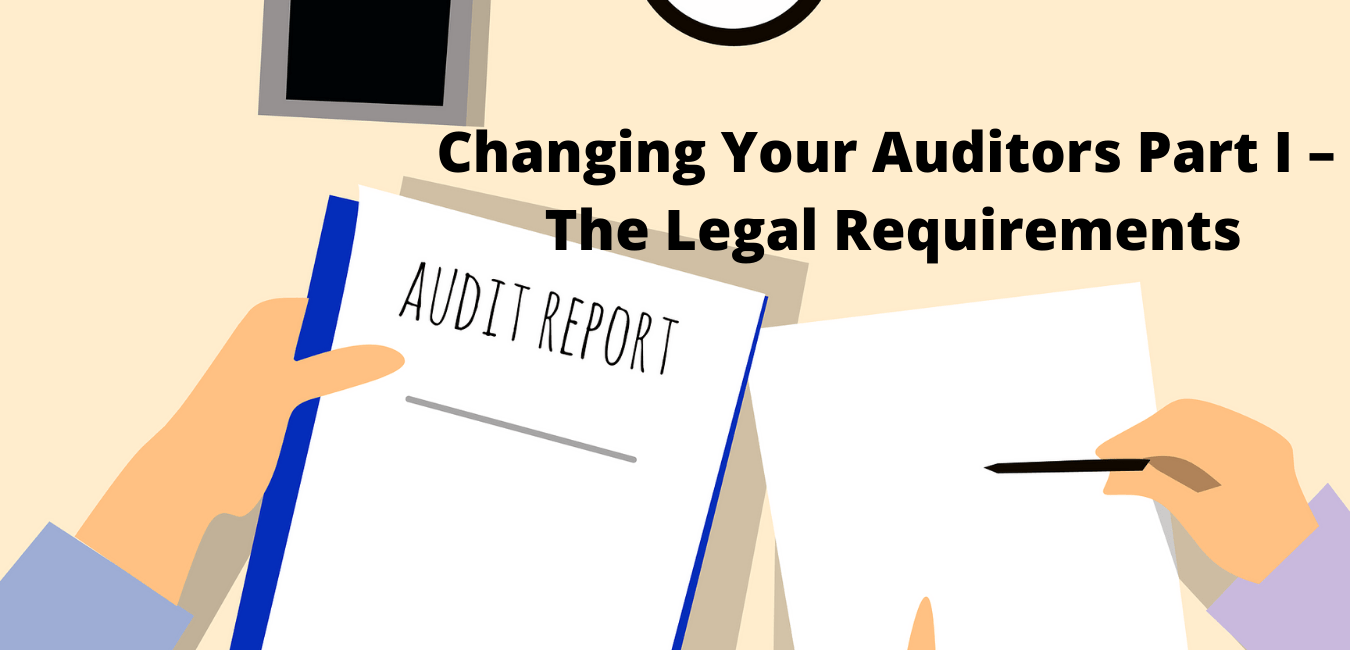by
Brian Koscak and Greg Hogan
Cassels Brock & Blackwell LLP
As part of obtaining a public listing or subsequent to a public listing, an “issuer”2 may determine that it is appropriate to change its current auditors. Making such a change is not a simple process, nor is it necessarily something that can be completed quickly. If an issuer is contemplating changing its auditor, it will need to address the requirements of its governing corporate statute and the requirements of any applicable securities laws (if the issuer is a “reporting issuer”3 at the time). In addition, the auditors will need to comply with the obligations imposed on them under their professional standards.
Circumstances Involving a Change of Auditor
While issuers and auditors may have a long working history together, there are circumstances where an issuer may need to change its auditors. These might include the following:
(i) Circumstances when an issuer’s auditor is not registered with the Canadian Public Accountability Board (“CPAB”) – under National Instrument 52-108 – Auditor Oversight, reporting issuers who file their financial statements with one or more Canadian securities regulators (the “Regulators”) are required to have auditors that participate in CPAB’s oversight program. An auditor must be registered with CPAB on the date that the auditor signs off on an audit report filed with the Regulators for an issuer;
(ii) An issuer may decide to dual list its shares in the United States – the rules of the Public Company Accounting Oversight Board (“PCAOB”) (CPAB’s counterpart in the United States) and the Sarbanes-Oxley Act require an auditor to be registered with the PCAOB to prepare or issue an audit report with respect to any issuer. Accordingly, a dual-listed issuer must engage an auditor that is both CPAB and PCAOB registered which may require a change of auditor;
(iii) Following a reverse take-over or other business combination – in these circumstances, more than one auditor may be involved. Issuers will have to make a choice as to which auditor best suits the needs of the resulting issuer going forward;
(iv) The issuer’s business is evolving and/or growing – as an issuer matures its business becomes more robust and complex. For example, issuers with operations in multiple countries with different tax jurisdictions require an auditor that can operate effectively in these locations;
(v) Conflict of Interest – The current auditor may have a conflict of interests or a loss of independence, thereby having to resign from the engagement; or
(vi) Other Reasons – an issuer may simply want to change its auditor because of its changing needs, relationships or for other business reasons.
While it may be desirable, an issuer cannot simply change auditors at any time, at least not without the cooperation of the current auditor and subject to certain requirements under corporate and securities law.
Corporate Law
Under Ontario corporate law (other Canadian jurisdictions will be similar), a change of auditor can occur if an auditor: (a) resigns; (b) is removed by the shareholders; or (c) or is not re-appointed for a subsequent financial year at the annual meeting of an issuer, each of which is discussed below.
Removal
The Business Corporations Act (Ontario) (the “OBCA”) provides that the shareholders of a corporation may remove an auditor before the expiration of the auditor’s term of office, by resolution passed by a majority of the votes cast at a special meeting of shareholders and shall by a majority of the votes cast at the meeting appoint a replacement for the remainder of the auditor’s term. The board of directors cannot simply remove the auditor.
Resignation
An issuer’s board could instead request the resignation of the auditor. Should the auditor agree to resign, the OBCA provides that its resignation is effective as of the time specified in the resignation or when the resignation is received by the corporation, whichever is later.
The OBCA provides that the directors may fill any casual vacancy in the office of auditor. Case law defines a casual vacancy as any vacancy not resulting from an expiration of time. As such, any vacancy occurring by death, resignation or bankruptcy is considered a casual vacancy. Therefore, in the event that the auditor resigns prior to the expiration of its appointed term, the directors of an issuer may appoint a new auditor.
Appointment
Under the OBCA, a successor auditor may not accept its appointment as auditor unless it has requested and received from the former auditor a written statement of the circumstances and the reasons why, in the former auditor’s opinion, that auditor is to be replaced. A person otherwise qualified to be an auditor may accept the appointment or consent to be appointed as auditor of a corporation if, within fifteen days after making the request referred to in that subsection, the person does not receive a reply.
Securities Law
If the issuer is a reporting issuer, a termination (which includes the issuer not re-appointing the auditor) or resignation of an issuer’s auditor and the subsequent appointment of a new auditor requires the issuer and the auditor to carry out certain actions, make certain disclosure and prepare certain documents.4 These are summarized below and are set out in Section 4.11 of National Instrument 51-102 – Continuous Disclosure Obligations (“NI 51-102”).
Upon a termination or resignation of its auditor, a reporting issuer must within 10 days after the date of termination or resignation:
- Prepare a “change of auditor notice” (see below) and deliver a copy of it to the former auditor; and
- Request the former auditor to review the reporting issuer’s change of auditor notice and prepare a letter, addressed to the Regulators and delivered to the reporting issuer within 20 days of the termination or resignation stating, for each statement in the change of auditor notice, whether the auditor (1) agrees, (2) disagrees, and the reasons why, or (3) has no basis to agree or disagree.
A reporting issuer must within 30 days after the date of termination or resignation:
- Have the audit committee of its board of directors or its board of directors review the letter from the former auditor referred to above if received by the reporting issuer, and approve the change of auditor notice;
- File a copy of the “reporting package” with the Regulators;
- Deliver a copy of the reporting package to the former auditor; and
- If there are any reportable events, issue and file a news release describing the information in the reporting package.
Appointment of Successor Auditor
Upon an appointment of a successor auditor, a reporting issuer must within 10 days after the date of appointment:
- Prepare a change of auditor notice and deliver it to the successor auditor and to the former auditor;
- Request the successor auditor to review the reporting issuer’s change of auditor notice and prepare a letter addressed to the Regulators and delivered to the reporting issuer within 20 days of the termination or resignation stating, for each statement in the change of auditor notice, whether the auditor (1) agrees, (2) disagrees, and the reasons why, or (3) has no basis to agree or disagree; and
- Request the former auditor to confirm within 20 days whether their letter referred to above need be updated, and if do, to update it.
A reporting issuer must within 30 days after the date of appointment:
- Have the audit committee of its board of directors or its board of directors review the letters from the successor auditor if received by the reporting issuer, and approve the change of auditor notice;
- File a copy of the reporting package with the regulators;
- Deliver a copy of the reporting package to the successor auditor and to the former auditor; and
- If there are any reportable events, issue and file a news release disclosing the appointment of the successor auditor and either describing the information in the reporting package or referring to the news release with respect to the resignation or termination of the former auditor.
The Documents
The main documents involved in a change of auditor are set out below.
A change of auditor notice must include certain prescribed information, including:
- whether the former auditor (i) resigned on the former auditor’s own initiative or at the reporting issuer’s request; (ii) was removed or is proposed to holders of qualified securities to be removed during the former auditor’s term of appointment; or (iii) was not reappointed or has not been proposed for reappointment;
- whether the former auditor’s report on any of the reporting issuer’s financial statements relating to the relevant period contained any reservation and, if so, a description of each reservation; and
- information regarding any disagreement, consultation, or unresolved issuer, each being a “reportable event” (see below).
The reporting package generally consists of:
- the change of auditor notice(s); and
- the letters from the former and successor auditors in respect of their review of the change of auditor notices(s).
A copy of the reporting package and a summary of the contents of the reporting package must be included in the issuer’s next management information circular.
Timeline
A sample timeline setting out the due dates of the documents and deliveries in the case where the termination of the former auditor and the appointment of the successor auditor occur concurrently is set out in Schedule “A”.
Reportable Event
The significant event in connection with a change of auditor is a “reportable event”. This means any disagreement, consultation or unresolved issue between a former auditor and reporting issuer. These terms are defined under under NI 51-102 and trigger certain disclosure requirements in the change of auditor notice which are set out for ease of reference in Schedule “B”.
CSE Requirements
The Canadian Securities Exchange does not impose any additional or special requirements on its listed issuers in connection with a change in auditors.
Recent Examples
Three recent examples of a change of auditor and the documents filed in relation thereto and publicly available on SEDAR are for Regal Energy Ltd.5, Taiga Building Products Ltd.6 and St. Andrew Goldfields Ltd.7
Stay Tuned for Part II
Part II of this paper will discuss the auditor’s perspective for a change of auditor including the criteria and processes that a successor auditor will undertake for accepting a new engagement. These include, for example, knowledge of the client’s business, a review of the former auditor’s working papers and independence issues that may impact on the successor auditor’s ability to accept the engagement. In other words, even if you want to change auditors, it does not mean that a potential successor auditor may want to change or can accept the engagement. Part II of this article will be written from an auditor’s perspective by Shane Hilkowitz CA of Zeifmans LLP.
This article is not intended to provide legal advice as individual situations will differ and should be discussed with a lawyer. For more information contact Brian Koscak or Greg Hogan at Cassels Brock & Blackwell LLP. Brian and Greg are partners specializing in corporate finance and securities law at Cassels Brock & Blackwell LLP, a full-service law firm located in Toronto, Ontario. Brian can be reached at 416.860.2955 or bkoscak@casselsbrock.com; Greg can be reached at 416.860.6554 or ghogan@casselsbrock.com.
The authors would also like to thank Shane Hilkowitz, CA of Zeifmans LLP for his contribution to this article. Shane can be reached at (416) 256-4000 Ext. 327 or hilkowitzs@zeifmans.ca.
1 Current as of May 20, 2009. 2An “issuer” means a person or company who has outstanding, issues or proposes to issue, a security. 3 A “reporting issuer” in connection with the Province of Ontario includes, but is not limited to, an issuer: (a) that has filed a prospectus and for which a receipt has been obtained under the Securities Act (Ontario); and (b) any of whose securities have been listed and posted for trading on any stock exchange in Ontario recognized by the Ontario Securities Commission (which includes the CSE), regardless of when such listing and posting for trading commence. 4 The authors note that there exemptions from the change of auditor requirements under NI 51-102 but which are outside the scope of this article.
5 See the filings made by Regal Energy Ltd. in May 2009 at: http://www.sedar.com/DisplayCompanyDocuments.do?lang=EN&issuerNo=00023201
6 See the filings made by Taiga Building Products Ltd. in January 2009 at http://www.sedar.com/DisplayCompanyDocuments.do?lang=EN&issuerNo=00022285
7 See the filings made by St. Andrew Goldfields in May 2007 at http://sedar.com/DisplayCompanyDocuments.do?lang=EN&issuerNo=00003240









